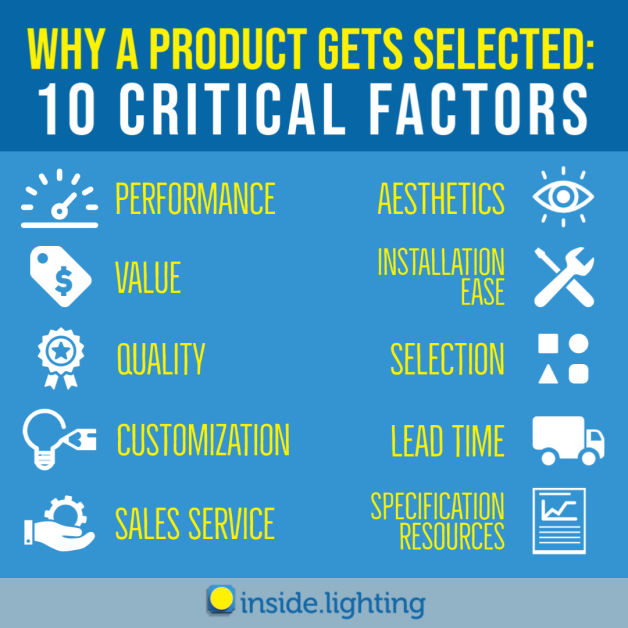
Why a Light Fixture is Selected ... or Not Selected.
If you’ve been in lighting for any amount of time, the list above might not include anything especially revolutionary, but it may serve as a good reminder about what really drives the fixture selections of lighting decision makers.
Recently we worked with a consulting client – a growing manufacturer facing challenges in gaining increased traction with commercial specifications. Together, we did a detailed analysis of the company’s value proposition in each of the 10 critical areas. We concluded that most customers treat 4-7 of the categories as must-haves and the rest of them as nice-to-haves. And the most important factors vary specifier to specifier – customer to customer – project to project.
One of the more interesting revelations from the analysis was that NOT checking one of the boxes – just one – could often times disqualify the manufacturer’s product from consideration altogether.
VALUE, AESTHETICS, QUALITY & PERFORMANCE
The obvious disqualifiers can be with products that are too high-end, too ugly, low quality, poor performing, incompatible with other systems or not DLC listed.
SPECIFICATION RESOURCES:
Do not underestimate the high importance of easy-to-find, high-quality specification resources. A fixture family that lacks Revit files might cause the manufacturer to lose spec opportunities without ever realizing it. Are the spec sheets thorough, detailed and easy to understand? And when a prospective customer visits the manufacturer’s website, what is the user experience? The need for really good specification resources is amplified even higher during these pandemic times.
INSTALLATION EASE
What if it takes the contractor 12 minutes to install Product A and 8 minutes to install Product B? A 4-minute difference might not sound like a lot, but that entails 50% more labor for the contractor -- which really adds up with large fixture quantities.
SELECTION
When a downlight family lacks sloped ceiling options or wall wash versions, they might lose the downlight specification for the entire project to another manufacturer that has the wider selection and can provide both standard and specialty products that addresses all of the downlight needs.
CUSTOMIZATION
Sometimes this factor is served by a product's field adjustability. Other times, if your company can manufacture modifications and “specials” you will likely get involved in more specs. One of the downside risks of custom capability is being solely considered for the specialty, lower-quantity project crumbs and not being specified for the higher volume fixtures.
LEAD TIME
Not every project is a rush, but if you quote 4-6 week lead time, be sure to state it because it’s the truth and not simply because it’s what the customer wants to hear.
Manufacturers: Remember, when you quote a lead time to your agent, they repeat that lead time to the customer. By doing so, the agent is putting his or her personal reputation on the line based on your promise. Deliver on those expectations and in the rare instances when you see trouble on the horizon be as proactive as possible in alerting the other stakeholders.
SALES SERVICE
This is possibly the most subjective of all the factors. Minimally, make sure that the factory or agency salesperson is well trained and knowledgeable. The qualities that often separate the great ones from the average ones include responsiveness, problem solving, reliability and skin-in-the-game customer empathy.
WHAT DO YOU THINK?
Did we miss any other major factors? We’d love to hear your comments and feedback on our correlating LinkedIn post.
Don’t miss the next big lighting story…Click here to subscribe to the inside.lighting InfoLetter |
